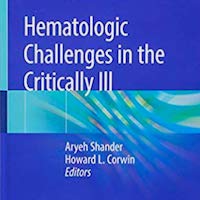Tag: sepsis
Methylene Blue in Sepsis and Septic Shock
This systematic review and meta-analysis evaluated the effect of MB in three RCTs. They found that MB treatment significantly reduced time to vasopressor discontinuation, days on mechanical ventilation, and length of ICU... read more
Cardiac Index and Heart Rate as Prognostic Indicators for Mortality in Septic Shock
Our retrospective study shows that monitoring cardiac index and heart rate in patients with septic shock may help predict the organismal response and hemodynamic consequences, as well as the prognosis. Thus, healthcare providers... read more
Fluid Personalization and Vasopressor Decisions in Early Sepsis Management
In this randomized vignette survey study of US critical care clinicians, we found that fluid volume already received was associated with the largest changes in decisions to administer additional fluids or initiate vasopressors... read more
AKI Risk Factors in ICU Patients Using Colistin
Colistin, an antibiotic of polymyxin group, has recently been increasingly used in the treatment of multidrug resistant gram-negative bacteria. However, it has serious adverse effects such as acute kidney injury (AKI). We... read more
Ilofotase Alfa Doesn’t Improved Survival Among Critically Ill Patients with SA-AKI
Sepsis-associated acute kidney injury (SA-AKI) in patients admitted to an intensive care unit is associated with significant morbidity and mortality. There is currently no pharmaceutical treatment. Although we found no... read more
Uncovering Heterogeneity in Sepsis
Among critically ill patients with sepsis, subtype strategies using clinical, biomarker, and transcriptomic data do not identify comparable patient populations and are likely to reflect disparate clinical characteristics... read more
Pediatric Sepsis Phenotype with Persistent Hypoxemia, Encephalopathy, and Shock
We derived and validated the persistent hypoxemia, encephalopathy, and shock phenotype, which is highly reproducible, clinically relevant, and associated with HTE to common adjuvant therapies in children with sepsis. We... read more
Genetic Causal Factors of ARDS
This comprehensive study highlights the importance of utilizing the MR-pheWAS framework in unraveling the complex etiology and pathogenesis of ARDS, and further underlines the value of integrating blood-based biomarkers into... read more
Screening Tools for Sepsis Identification
The authors undertook a rapid review to determine the suitability of sepsis screening tools in the emergency setting with regard to sensitivity and specificity of sepsis diagnosis. The review recognized that there is currently... read more
Endotoxin Role in Septic Shock
Septic shock can be caused by a variety of mechanisms including direct effects of bacterial toxins such as endotoxin. Annually, approximately 5–7 million patients worldwide develop sepsis with very high endotoxin activity... read more
Simple Blood Test Indicating Sepsis Relapse
Sepsis is often not adequately diagnosed at the early stage when it could still be potentially avoidable. In this report, we describe the dramatic hematological changes found in the blood of a sepsis survivor just after discharge... read more
COVID-19-associated Sepsis: Incidence and Mortality
In this retrospective cohort study of hospitalized adults, SARS-CoV-2 accounted for approximately 1 in 6 cases of sepsis during the first 33 months of the COVID-19 pandemic. In-hospital mortality rates for SARS-CoV-2–associated... read more
Levels of Intensive Care vs. In-Hospital Mortality in Patients Hospitalized for Sepsis Stratified by SOFA
Patients hospitalized for sepsis with Sequential Organ Failure Assessment (SOFA) scores greater than or equal to 6 in the ICU or HDU had lower in-hospital mortality than those in the general ward, as did those with SOFA scores... read more
Enteral Citrulline Supplementation vs. Placebo in Mechanically Ventilated Patients
Among mechanically ventilated ICU patients without sepsis or septic shock, enteral L-citrulline administration did not result in a significant difference in SOFA score on day 7 compared to placebo. Of 120 randomized patients... read more
Roadblock: AFib with RVR
In this paper we focus on strategies to bypass the most common pitfalls in our treatment algorithm when treating patients who present to the ED in atrial fibrillation with RVR. We all know the few medications in our toolbox... read more
Urine Output-based Sepsis-associated AKI: Clinical Implications
This paper offers comprehensive insights into the epidemiology of acute kidney injury (AKI), and we commend the authors for their significant contribution. They revealed an increase in the number of mild cases among AKI stage... read more
Anticoagulation in the ICU: Contact Pathway Inhibition Future
Bleeding and thrombotic complications are the main cause of morbidity and mortality in critically ill patients on the intensive care unit (ICU), receiving short-term percutaneous mechanical circulatory support (pMCS) by extracorporeal... read more
Hematologic Challenges in the Critically Ill
This volume provides a comprehensive overview of hematologic issues that clinicians regularly encounter in the critical care environment. The text features hematologic scenarios that affect the adult ICU patient, outlines... read more

Sepsis Prediction Model for Determining Sepsis vs. SIRS, qSOFA, and SOFA
In this cohort study of 60,507 hospital admissions, we found that although the SPM marginally outperformed existing prediction scores in balanced accuracy for classification of sepsis, it suffers from poor timeliness, limiting... read more
Novel Vasopressor Agent Adoption in Critically Ill Adults
This study aimed to investigate the utilisation of ATII in critically ill adults undergoing vasopressor therapy. The study included patients admitted to ICUs from January 1, 2018, to December 31, 2020, who received intravenous... read more
The Vasopressin Loading for Refractory Septic Shock Study
Vasopressin loading may be safely introduced for septic shock. Vasopressin loading may be used to predict responses to its continuous infusion and select appropriate strategies to increase blood pressure. 92 patients were... read more
Blood Purification for Adult Patients with Sepsis
Our network meta-analysis (NMA) suggests that plasma exchange and polymyxin-B hemoperfusion may provide potential benefits for adult patients with severe infection or sepsis/septic shock when compared with standard care alone,... read more









